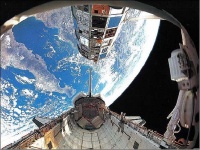LDEF 1
From The Space Library
 | |
| Organization | NASA-Office of Space Science Applications (United States) |
|---|---|
| Mission type | Life Science,Space Physics |
| Launch date | April 6, 1984 |
| Launch vehicle | STS-41C |
| Carrier rocket | Space Shuttle |
| Launch site | Cape Canaveral, United States |
| COSPAR ID | 1984-034B |
| Mass | 9710.0 kg |
| Alternate Names | LDEF, LDEF 1/STS 41C, LDEF-A, Long Duration Exposure Facility, 14898 |
| Additional Information | Here |
| PDMP Information | Here |
| Telecommunications Information | Here |
The Long Duration Exposure Facility (LDEF) was developed by the NASA Office of Aeronautics and Space Technology and the NASA/Langley Research Center. The purpose of the LDEF was to accommodate, using the Shuttle, a class of technology, science, and applications experiments that require a free-flying exposure in space. These experiments benefit from postflight laboratory studies with the retrieved experiment hardware. The LDEF was a simple reusable structure approximately 4.3 m in diameter and 9.1 m in length. The experiments were contained in trays mounted to the structure. While the LDEF had no central power or data system, it did, however, provide initiation and termination signals at the start and end of the mission. Any required power and/or data systems were included by the experimenter in his respective tray. Standard Experiment Power and Data Systems were designed for use in LDEF trays and these could be procured by the experimenters. The LDEF had a gravity-gradient stabilized orbit orientation. In January 1990, during the flight of STS-32, (1990-002A), the LDEF was retrieved and returned to Earth. It is being examined by investigation groups composed of specialists in meteoroids and space debris, materials, spacecraft systems, and radiation. Following the examinations, it is planned to remove the experiment trays from the LDEF structure and to distribute them to the investigators for data analysis.
